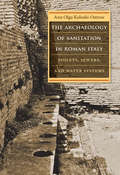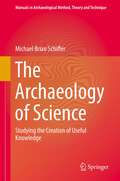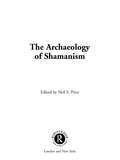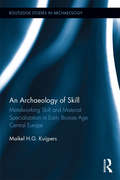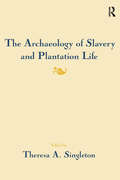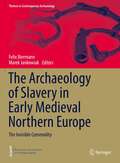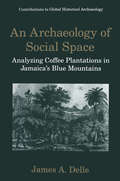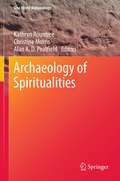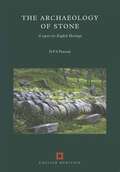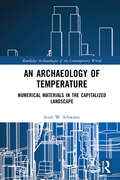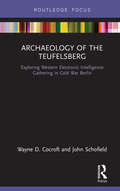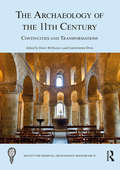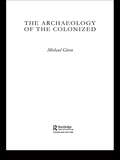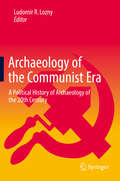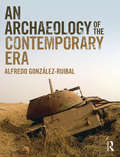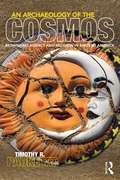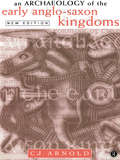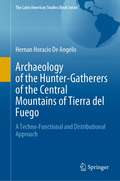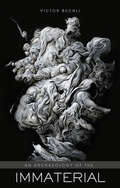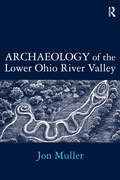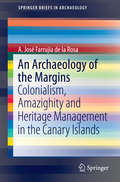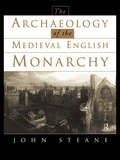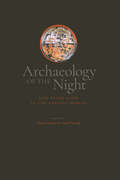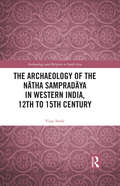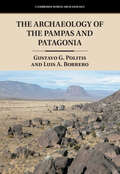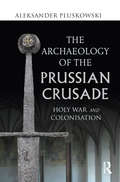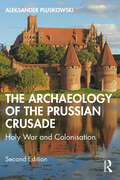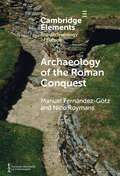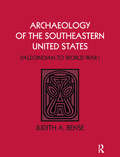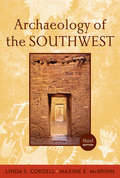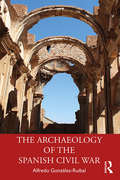- Table View
- List View
The Archaeology of Sanitation in Roman Italy: Toilets, Sewers, and Water Systems (Studies in the History of Greece and Rome)
by Ann Olga Koloski-OstrowThe Romans developed sophisticated methods for managing hygiene, including aqueducts for moving water from one place to another, sewers for removing used water from baths and runoff from walkways and roads, and public and private latrines. Through the archeological record, graffiti, sanitation-related paintings, and literature, Ann Olga Koloski-Ostrow explores this little-known world of bathrooms and sewers, offering unique insights into Roman sanitation, engineering, urban planning and development, hygiene, and public health. Focusing on the cities of Pompeii, Herculaneum, Ostia, and Rome, Koloski-Ostrow's work challenges common perceptions of Romans' social customs, beliefs about health, tolerance for filth in their cities, and attitudes toward privacy. In charting the complex history of sanitary customs from the late republic to the early empire, Koloski-Ostrow reveals the origins of waste removal technologies and their implications for urban health, past and present.
The Archaeology of Science: Studying the Creation of Useful Knowledge (Manuals in Archaeological Method, Theory and Technique #9)
by Michael Brian SchifferThis manual pulls together—and illustrates with interesting case studies—the variety of specialized and generalized archaeological research strategies that yield new insights into science. Throughout the book there are templates, consisting of questions, to help readers visualize and design their own projects. The manual seeks to be as general as possible, applicable to any society, and so science is defined as the creation of useful knowledge—the kinds of knowledge that enable people to make predictions. The chapters in Part I discuss the scope of the archaeology of science and furnish a conceptual foundation for the remainder of the book. Next, Part II presents several specialized, but widely practiced, research strategies that contribute to the archaeology of science. In order to thoroughly ground the manual in real-life applications, Part III presents lengthy case studies that feature the use of historical and archaeological evidence in the study of scientific activities.
The Archaeology of Shamanism
by Neil PriceIn this timely collection, Neil Price provides a general introduction to the archaeology of shamanism by bringing together recent archaeological thought on the subject. Blending theoretical discussion with detailed case studies, the issues addressed include shamanic material culture, responses to dying and the dead, shamanic soundscapes, the use of ritual architecture and shamanism in the context of other belief systems such as totemism. Following an intial orientation reviewing shamanism as an anthropological construct, the volume focuses on the Northern hemisphere with case studies from Greenland to Nepal, Siberia to Kazakhstan. The papers span a chronological range from Upper Palaeolithic to the present and explore such cross-cutting themes as gender and the body, identity, landscape, architecture, as well as shamanic interpretations of rock art and shamanism in the heritage and cultural identity of indigenous peoples. The volume also addresses the interpretation of shamanic beliefs in terms of cognitive neuroscience and the modern public perception of prehistoric shamanism.
The Archaeology of Shamanism
by Neil S. PriceIn this timely collection, Neil Price provides a general introduction to the archaeology of shamanism by bringing together recent archaeological thought on the subject. Blending theoretical discussion with detailed case studies, the issues addressed include shamanic material culture, responses to dying and the dead, shamanic soundscapes, the use of ritual architecture and shamanism in the context of other belief systems such as totemism. Following an intial orientation reviewing shamanism as an anthropological construct, the volume focuses on the Northern hemisphere with case studies from Greenland to Nepal, Siberia to Kazakhstan. The papers span a chronological range from Upper Palaeolithic to the present and explore such cross-cutting themes as gender and the body, identity, landscape, architecture, as well as shamanic interpretations of rock art and shamanism in the heritage and cultural identity of indigenous peoples. The volume also addresses the interpretation of shamanic beliefs in terms of cognitive neuroscience and the modern public perception of prehistoric shamanism.
An Archaeology of Skill: Metalworking Skill and Material Specialization in Early Bronze Age Central Europe (Routledge Studies in Archaeology)
by Maikel H.G. KuijpersMaterial is the mother of innovation and it is through skill that innovations are brought about. This core thesis that is developed in this book identifies skill as the linchpin of – and missing link between – studies on craft, creativity, innovation, and material culture. Through a detailed study of early bronze age axes the question is tackled of what it involves to be skilled, providing an evidence based argument about levels of skill. The unique contribution of this work is that it lays out a theoretical framework and methodology through which an empirical analysis of skill is achievable. A specific chaîne opératoire for metal axes is used that compares not only what techniques were used, but also how they were applied. A large corpus of axes is compared in terms of what skills and attention were given at the different stages of their production. The ideas developed in this book are of interest to the emerging trend of ‘material thinking’ in the human and social sciences. At the same time, it looks towards and augments the development in craft-studies, recognising the many different aspects of craft in contemporary and past societies, and the particular relationship that craftspeople have with their material. Drawing together these two distinct fields of research will stimulate (re)thinking of how to integrate production with discussions of other aspects of object biographies, and how we link arguments about value to social models.
An Archaeology of Skill: Metalworking Skill and Material Specialization in Early Bronze Age Central Europe (Routledge Studies in Archaeology)
by Maikel H.G. KuijpersMaterial is the mother of innovation and it is through skill that innovations are brought about. This core thesis that is developed in this book identifies skill as the linchpin of – and missing link between – studies on craft, creativity, innovation, and material culture. Through a detailed study of early bronze age axes the question is tackled of what it involves to be skilled, providing an evidence based argument about levels of skill. The unique contribution of this work is that it lays out a theoretical framework and methodology through which an empirical analysis of skill is achievable. A specific chaîne opératoire for metal axes is used that compares not only what techniques were used, but also how they were applied. A large corpus of axes is compared in terms of what skills and attention were given at the different stages of their production. The ideas developed in this book are of interest to the emerging trend of ‘material thinking’ in the human and social sciences. At the same time, it looks towards and augments the development in craft-studies, recognising the many different aspects of craft in contemporary and past societies, and the particular relationship that craftspeople have with their material. Drawing together these two distinct fields of research will stimulate (re)thinking of how to integrate production with discussions of other aspects of object biographies, and how we link arguments about value to social models.
The Archaeology of Slavery and Plantation Life
by Theresa A SingletonThis volume represented a compilation of interdisciplinary research being done throughout the American South and the Caribbean by historians, archaeologists, architects, anthropologists, and other scholars on the topic of slavery and plantations. It synthesizes materials known through the 1980s and reports on key sites of excavation and survey in the Carolinas, Barbados, Louisiana and other locations. Contributors include many of the leading figures in historical archaeology.
The Archaeology of Slavery and Plantation Life
by Theresa A SingletonThis volume represented a compilation of interdisciplinary research being done throughout the American South and the Caribbean by historians, archaeologists, architects, anthropologists, and other scholars on the topic of slavery and plantations. It synthesizes materials known through the 1980s and reports on key sites of excavation and survey in the Carolinas, Barbados, Louisiana and other locations. Contributors include many of the leading figures in historical archaeology.
The Archaeology of Slavery in Early Medieval Northern Europe: The Invisible Commodity (Themes in Contemporary Archaeology)
by Felix Biermann Marek JankowiakThis volume is the first comprehensive study of the material imprint of slavery in early medieval Europe. While written sources attest to the ubiquity of slavery and slave trade in early medieval British Isles, Scandinavia and Slavic lands, it is still difficult to find material traces of this reality, other than the hundreds of thousands of Islamic coins paid in exchange for the northern European slaves. This volume offers the first structured reflection on how to bridge this gap. It reviews the types of material evidence that can be associated with the institution of slavery and the slave trade in early medieval northern Europe, from individual objects (such as e.g. shackles) to more comprehensive landscape approaches.The book is divided into four sections. The first presents the analytical tools developed in Africa and prehistoric Europe to identify and describe social phenomena associated with slavery and the slave trade. The following three section review the three main cultural zones of early medieval northern Europe: the British Isles, Scandinavia, and Slavic central Europe. The contributions offer methodological reflections on the concept of the archaeology of slavery. They emphasize that the material record, by its nature, admits multiple interpretations. More broadly, this book comes at a time when the history of slavery is being integrated into academic syllabi in most western countries. The collection of studies contributes to a more nuanced perspective on this important and controversial topic. This volume appeals to multiple audiences interested in comparative and global studies of slavery, and will constitute the point of reference for future debates.
An Archaeology of Social Space: Analyzing Coffee Plantations in Jamaica’s Blue Mountains (Contributions To Global Historical Archaeology)
by James A. DelleJames Delle has solved a number of problems in Caribbean archaeology with An Archaeology of Social Space. He deals with most of the problems by using historical archaeology, and clearly implicates Ameri canist prehistorians. Although this book is about coffee plantations in the Blue Mountains area of Jamaica, it is actually about the whole Caribbean. Just as it is about all archaeology, not only historical archaeology, it is also a book about colonialism and national inde pendence and how these two enormous events happened in the context of eighteenth and nineteenth century capitalism. The first issue raised appears to be an academic topic that has come to be known as landscape archaeology. Landscape archaeology considers the planned spaces around living places. The topic is big, comprehensive, and new within historical archaeology. Its fundamen tal insight is that in the early modern and modern worlds everything within view could be made into money. Seeing occurs in space and from 1450, or a little before, everything that could be seen could, potentially, be measured. The measuring-and the accompanying culture of record ing called a scriptural economy-became a way of controlling people in space, for a profit. Dr. Delle thus explores maps, local philosophies of settlement, town dwelling, housing, and the actual condition of plantations and their buildings now, so as to describe coffee-Jamaica from 1790-1860.
Archaeology of Spiritualities (One World Archaeology)
by Kathryn Rountree, Christine Morris and Alan A. D. PeatfieldArchaeology of Spiritualties provides a fresh exploration of the interface between archaeology and religion/spirituality. Archaeological approaches to the study of religion have typically and often unconsciously, drawn on western paradigms, especially Judaeo-Christian (mono) theistic frameworks and academic rationalisations. Archaeologists have rarely reflected on how these approaches have framed and constrained their choices of methodologies, research questions, hypotheses, definitions, interpretations and analyses and have neglected an important dimension of religion: the human experience of the numinous - the power, presence or experience of the supernatural.Within the religions of many of the world’s peoples, sacred experiences – particularly in relation to sacred landscapes and beings connected with those landscapes – are often given greater emphasis, while doctrine and beliefs are relatively less important. Archaeology of Spiritualities asks how such experiences might be discerned in the archaeological record; how do we recognize and investigate ‘other’ forms of religious or spiritual experience in the remains of the past?.The volume opens up a space to explore critically and reflexively the encounter between archaeology and diverse cultural expressions of spirituality. It showcases experiential and experimental methodologies in this area of the discipline, an unconventional approach within the archaeology of religion. Thus Archaeology of Spiritualities offers a unique, timely and innovative contribution, one that is also challenging and stimulating. It is a great resource to archaeologists, historians, religious scholars and others interested in cultural and religious heritage.
The Archaeology of Stone: A report for English Heritage (English Heritage)
by D P PeacockEnglish Heritage's 'Exploring our past' (1991) identified stone in archaeology as a problem area: 'The sources, manufacture and distribution of stone artifacts remain poorly understood, whether these are the cutting tools of prehistory, such as axes and knives, or grinding implements such as hones and querns'. It further states that a commissioned assessment of stone in archaeology should identify basic recording standards, guidelines for processing, shortcomings in regional and local sequences, and potential themes for future study. 'The archaeology of stone' is the result of this commissioned report. Considering all types of stone other than flint, which is considered a special case, and using a combination of library work, site visits, and interviews with practitioners, Professor Peacock's report considers retention and processing policies, evaluates the needs of stone identification and provenancing, and examines ways of recording technological traces of stone working or use. In addition to stone axes, hones, and querns, a major area of concern is with building materials, where sheer quantities often overwhelm even the most smoothly run operations. In addition, consideration of standing buildings helps to put excavated material into a wider context. He concludes with recommendations that point to areas where more research and evaluation are needed, based firmly on the necessary condition that any changes to current practices must be demonstrably useful, and lead to a substantially better understanding of the past.
An Archaeology of Temperature: Numerical Materials in the Capitalized Landscape (Routledge Archaeologies of the Contemporary World)
by Scott W. SchwartzThis work investigates the material culture of public temperatures in New York City. Numbers like temperature, while ubiquitous and indispensable to capitalized social relations, are often hidden away within urban infrastructures evading attention. This Archaeology of Temperature brings such numbers to light, interrogating how we construct them and how they construct us. Building on discussions in contemporary archaeology this book challenges the border between material and discursive culture, advocating for a novel conception of capitalism’s artifacts. The artifacts examined within (temperatures) are instantaneous electric pulses, algorithmic outputs, and momentary fluctuations in mercury. The artifacts of the capitalized never sit still, operating at subatomic and solar scales. Temperatures, as numerical materials precariously straddling the colonially constructed nature-culture divide, exemplify the abstraction necessary to pursue the perpetually accelerating asymmetrical growth of wealth—a pursuit that engenders multiple environmental and economic calamities. An Archaeology of Temperature innovatively reimagines theory and method within contemporary archaeology. Equally, in plummeting the depths of temperature, this book offers indispensable contributions to science studies, urban geography, semiotics, the philosophy of materiality, the history of thermodynamics, heterodox economics, performative scholarship, and queer ecocriticism.
An Archaeology of Temperature: Numerical Materials in the Capitalized Landscape (Routledge Archaeologies of the Contemporary World)
by Scott W. SchwartzThis work investigates the material culture of public temperatures in New York City. Numbers like temperature, while ubiquitous and indispensable to capitalized social relations, are often hidden away within urban infrastructures evading attention. This Archaeology of Temperature brings such numbers to light, interrogating how we construct them and how they construct us. Building on discussions in contemporary archaeology this book challenges the border between material and discursive culture, advocating for a novel conception of capitalism’s artifacts. The artifacts examined within (temperatures) are instantaneous electric pulses, algorithmic outputs, and momentary fluctuations in mercury. The artifacts of the capitalized never sit still, operating at subatomic and solar scales. Temperatures, as numerical materials precariously straddling the colonially constructed nature-culture divide, exemplify the abstraction necessary to pursue the perpetually accelerating asymmetrical growth of wealth—a pursuit that engenders multiple environmental and economic calamities. An Archaeology of Temperature innovatively reimagines theory and method within contemporary archaeology. Equally, in plummeting the depths of temperature, this book offers indispensable contributions to science studies, urban geography, semiotics, the philosophy of materiality, the history of thermodynamics, heterodox economics, performative scholarship, and queer ecocriticism.
Archaeology of The Teufelsberg: Exploring Western Electronic Intelligence Gathering in Cold War Berlin (Routledge Archaeologies of the Contemporary World)
by Wayne D Cocroft John SchofieldFor over 50 years, the white radomes of the Teufelsberg have been one of Berlin’s most prominent landmarks. For half of this time the city lay over 100 miles behind an 'Iron Curtain' that divided East from West, and was surrounded by communist East Germany and the densest concentration of Warsaw Pact military forces in Europe. From the vantage point high on the Teufelsberg, British and American personnel constantly monitored the electronic emissions from the surrounding military forces, as well as high-level political intelligence. Today, the Teufelsberg stands as a contemporary and spectacular ruin, representing a significant relic of a lost cyber space of Cold War electronic emissions and espionage. Based on archaeological fieldwork and recently declassified documents, this book presents a new history of the Teufelsberg and other Western intelligence gathering sites in Berlin. At a time when intelligence gathering is once more under close scrutiny, when questions are being asked about the intelligence relationship between the United States and Russia, and amidst wider debate about the US’s National Security Agency (NSA) intelligence programmes, sites like the Teufelsberg raise questions that appear both important and timely.
Archaeology of The Teufelsberg: Exploring Western Electronic Intelligence Gathering in Cold War Berlin (Routledge Archaeologies of the Contemporary World)
by Wayne D Cocroft John SchofieldFor over 50 years, the white radomes of the Teufelsberg have been one of Berlin’s most prominent landmarks. For half of this time the city lay over 100 miles behind an 'Iron Curtain' that divided East from West, and was surrounded by communist East Germany and the densest concentration of Warsaw Pact military forces in Europe. From the vantage point high on the Teufelsberg, British and American personnel constantly monitored the electronic emissions from the surrounding military forces, as well as high-level political intelligence. Today, the Teufelsberg stands as a contemporary and spectacular ruin, representing a significant relic of a lost cyber space of Cold War electronic emissions and espionage. Based on archaeological fieldwork and recently declassified documents, this book presents a new history of the Teufelsberg and other Western intelligence gathering sites in Berlin. At a time when intelligence gathering is once more under close scrutiny, when questions are being asked about the intelligence relationship between the United States and Russia, and amidst wider debate about the US’s National Security Agency (NSA) intelligence programmes, sites like the Teufelsberg raise questions that appear both important and timely.
The Archaeology of the 11th Century: Continuities and Transformations (The Society for Medieval Archaeology Monographs)
by Christopher Dyer Dawn M. HadleyThe Archaeology of the 11th Century addresses many key questions surrounding this formative period of English history and considers conditions before 1066 and how these changed. The impact of the Conquest of England by the Normans is the central focus of the book, which not only assesses the destruction and upheaval caused by the invading forces, but also examines how the Normans contributed to local culture, religion, and society. The volume explores a range of topics including food culture, funerary practices, the development of castles and their impact, and how both urban and rural life evolved during the 11th century. Through its nuanced approach to the complex relationships and regional identities which characterised the period, this collection stimulates renewed debate and challenges some of the long-standing myths surrounding the Conquest. Presenting new discoveries and fresh ideas in a readable style with numerous illustrations, this interdisciplinary book is an invaluable resource for those interested in the archaeology, history, geography, art, and literature of the 11th century.
The Archaeology of the 11th Century: Continuities and Transformations (The Society for Medieval Archaeology Monographs)
by Christopher Dyer Dawn M. HadleyThe Archaeology of the 11th Century addresses many key questions surrounding this formative period of English history and considers conditions before 1066 and how these changed. The impact of the Conquest of England by the Normans is the central focus of the book, which not only assesses the destruction and upheaval caused by the invading forces, but also examines how the Normans contributed to local culture, religion, and society. The volume explores a range of topics including food culture, funerary practices, the development of castles and their impact, and how both urban and rural life evolved during the 11th century. Through its nuanced approach to the complex relationships and regional identities which characterised the period, this collection stimulates renewed debate and challenges some of the long-standing myths surrounding the Conquest. Presenting new discoveries and fresh ideas in a readable style with numerous illustrations, this interdisciplinary book is an invaluable resource for those interested in the archaeology, history, geography, art, and literature of the 11th century.
The Archaeology of the Colonized
by Michael GivenThe first book to integrate fully the archaeological study of the landscape with the concerns of colonial and postcolonial history, theory and scholarship, The Archaeology of the Colonized focuses on the experience of the colonized in their landscape setting, looking at case studies from areas of the world not often considered in the postcolonial debate. It offers original, exciting approaches to the growing area of research in archaeology and colonialism. From the pyramids of Old Kingdom Egypt to illicit whisky distilling in nineteenth-century Scotland, and from the Roman roads of Turkey to the threshing floors of Cyprus under British colonial rule, the case studies assist Dr. Given as he uses the archaeological evidence to create a vivid picture of how the lives and identities of farmers, artisans and labourers were affected by colonial systems of oppressive taxation, bureaucracy, forced labour and ideological control. This will be valuable to students, scholars or professionals investigating the relationship between local community and central control in a wide range of historical and archaeological contexts.
The Archaeology of the Colonized
by Michael GivenThe first book to integrate fully the archaeological study of the landscape with the concerns of colonial and postcolonial history, theory and scholarship, The Archaeology of the Colonized focuses on the experience of the colonized in their landscape setting, looking at case studies from areas of the world not often considered in the postcolonial debate. It offers original, exciting approaches to the growing area of research in archaeology and colonialism. From the pyramids of Old Kingdom Egypt to illicit whisky distilling in nineteenth-century Scotland, and from the Roman roads of Turkey to the threshing floors of Cyprus under British colonial rule, the case studies assist Dr. Given as he uses the archaeological evidence to create a vivid picture of how the lives and identities of farmers, artisans and labourers were affected by colonial systems of oppressive taxation, bureaucracy, forced labour and ideological control. This will be valuable to students, scholars or professionals investigating the relationship between local community and central control in a wide range of historical and archaeological contexts.
Archaeology of the Communist Era: A Political History of Archaeology of the 20th Century
by Ludomir R LoznyThis book contributes to better recognition and comprehension of the interconnection between archaeology and political pressure, especially imposed by the totalitarian communist regimes. It explains why, under such political conditions, some archaeological reasoning and practices were resilient, while new ideas leisurely penetrated the local scenes. It attempts to critically evaluate the political context and its impact on archaeology during the communist era world wide and contributes to better perception of the relationship between science and politics in general. This book analyzes the pressures inflicted on archaeologists by the overwhelmingly potent political environment, which stimulates archaeological thought and controls the conditions for professional engagement. Included are discussions about the perception of archaeology and its findings by the public.
An Archaeology of the Contemporary Era: The Age of Destruction
by Alfredo Gonzalez-RuibalAn Archaeology of the Contemporary Era approaches the contemporary age, between the late nineteenth and twenty-first centuries, as an archaeological period defined by specific material processes. It reflects on the theory and practice of the archaeology of the contemporary past from epistemological, political, ethical and aesthetic viewpoints, and characterises the present based on archaeological traces from the spatial, temporal and material excesses that define it. The materiality of our era, the book argues, and particularly its ruins and rubbish, reveals something profound, original and disturbing about humanity. This is the first attempt at describing the contemporary era from an archaeological point of view. Global in scope, the book brings together case studies from every continent and considers sources from peripheral and rarely considered traditions, meanwhile engaging in an interdisciplinary dialogue with philosophy, anthropology, history and geography. An Archaeology of the Contemporary Era will be essential reading for students and practitioners of the archaeology of the contemporary past, historical archaeology and archaeological theory. It will also be of interest to anybody concerned with globalisation, modernity and the Anthropocene.
An Archaeology of the Contemporary Era: The Age of Destruction
by Alfredo Gonzalez-RuibalAn Archaeology of the Contemporary Era approaches the contemporary age, between the late nineteenth and twenty-first centuries, as an archaeological period defined by specific material processes. It reflects on the theory and practice of the archaeology of the contemporary past from epistemological, political, ethical and aesthetic viewpoints, and characterises the present based on archaeological traces from the spatial, temporal and material excesses that define it. The materiality of our era, the book argues, and particularly its ruins and rubbish, reveals something profound, original and disturbing about humanity. This is the first attempt at describing the contemporary era from an archaeological point of view. Global in scope, the book brings together case studies from every continent and considers sources from peripheral and rarely considered traditions, meanwhile engaging in an interdisciplinary dialogue with philosophy, anthropology, history and geography. An Archaeology of the Contemporary Era will be essential reading for students and practitioners of the archaeology of the contemporary past, historical archaeology and archaeological theory. It will also be of interest to anybody concerned with globalisation, modernity and the Anthropocene.
An Archaeology of the Cosmos: Rethinking Agency and Religion in Ancient America
by Timothy R. PauketatAn Archaeology of the Cosmos seeks answers to two fundamental questions of humanity and human history. The first question concerns that which some use as a defining element of humanity: religious beliefs. Why do so many people believe in supreme beings and holy spirits? The second question concerns changes in those beliefs. What causes beliefs to change? Using archaeological evidence gathered from ancient America, especially case material from the Great Plains and the pre-Columbian American Indian city of Cahokia, Timothy Pauketat explores the logical consequences of these two fundamental questions. Religious beliefs are not more resilient than other aspects of culture and society, and people are not the only causes of historical change. An Archaeology of the Cosmos examines the intimate association of agency and religion by studying how relationships between people, places, and things were bundled together and positioned in ways that constituted the fields of human experience. This rethinking theories of agency and religion provides readers with challenging and thought provoking conclusions that will lead them to reassess the way they approach the past.
An Archaeology of the Cosmos: Rethinking Agency and Religion in Ancient America
by Timothy R. PauketatAn Archaeology of the Cosmos seeks answers to two fundamental questions of humanity and human history. The first question concerns that which some use as a defining element of humanity: religious beliefs. Why do so many people believe in supreme beings and holy spirits? The second question concerns changes in those beliefs. What causes beliefs to change? Using archaeological evidence gathered from ancient America, especially case material from the Great Plains and the pre-Columbian American Indian city of Cahokia, Timothy Pauketat explores the logical consequences of these two fundamental questions. Religious beliefs are not more resilient than other aspects of culture and society, and people are not the only causes of historical change. An Archaeology of the Cosmos examines the intimate association of agency and religion by studying how relationships between people, places, and things were bundled together and positioned in ways that constituted the fields of human experience. This rethinking theories of agency and religion provides readers with challenging and thought provoking conclusions that will lead them to reassess the way they approach the past.
An Archaeology of the Early Anglo-Saxon Kingdoms
by C. J. ArnoldAn Archaeology of the Early Anglo-Saxon Kingdoms is a volume which offers an unparalleled view of the archaeological remains of the period. Using the development of the kingdoms as a framework, this study closely examines the wealth of material evidence and analyzes its significance to our understanding of the society that created it. From our understanding of the migrations of the Germanic peoples into the British Isles, the subsequent patterns of settlement, land-use, trade, through to social hierarchy and cultural identity within the kingdoms, this fully revised edition illuminates one of the most obscure and misunderstood periods in European history.
An Archaeology of the Early Anglo-Saxon Kingdoms
by C. J. ArnoldAn Archaeology of the Early Anglo-Saxon Kingdoms is a volume which offers an unparalleled view of the archaeological remains of the period. Using the development of the kingdoms as a framework, this study closely examines the wealth of material evidence and analyzes its significance to our understanding of the society that created it. From our understanding of the migrations of the Germanic peoples into the British Isles, the subsequent patterns of settlement, land-use, trade, through to social hierarchy and cultural identity within the kingdoms, this fully revised edition illuminates one of the most obscure and misunderstood periods in European history.
Archaeology of the Hunter-Gatherers of the Central Mountains of Tierra del Fuego: A Techno-Functional and Distributional Approach (The Latin American Studies Book Series)
by Hernan Horacio De AngelisThis work book contributes to the knowledge about human settlements in the Isla Grande of Tierra Del Fuego by the hunter-gatherer societies that inhabited the area until the early twentieth century. The central theme is the study of technological organization as an approach to the management strategies of biotic and abiotic resources, as well as the occupation of space, considering the different environments represented in the area and the differential supply of resources. As a general framework, the book proposes instrumental methodologies that allow us to look at the characterization of the social and economic organization of hunter-gatherer societies from the point of view of the analysis of natural resources management, the resources introduced by Europeans and the spatial organization of technical activities.
An Archaeology of the Immaterial
by Victor BuchliAn Archaeology of the Immaterial examines a highly significant but poorly understood aspect of material culture studies: the active rejection of the material world. Buchli argues that this is evident in a number of cultural projects, including anti-consumerism and asceticism, as well as other attempts to transcend material circumstances. Exploring the cultural work which can be achieved when the material is rejected, and the social effects of these ‘dematerialisations’, this book situates the way some people disengage from the world as a specific kind of physical engagement which has profound implications for our understanding of personhood and materiality. Using case studies which range widely in time over Western societies and the technologies of materialising the immaterial, from icons to the scanning tunnelling microscope and 3-D printing, Buchli addresses the significance of immateriality for our own economics, cultural perceptions, and emerging forms of social inclusion and exclusion. An Archaeology of the Immaterial is thus an important and innovative contribution to material cultural studies which demonstrates that the making of the immaterial is, like the making of the material, a profoundly powerful operation which works to exert social control and delineate the borders of the imaginable and the enfranchised.
An Archaeology of the Immaterial
by Victor BuchliAn Archaeology of the Immaterial examines a highly significant but poorly understood aspect of material culture studies: the active rejection of the material world. Buchli argues that this is evident in a number of cultural projects, including anti-consumerism and asceticism, as well as other attempts to transcend material circumstances. Exploring the cultural work which can be achieved when the material is rejected, and the social effects of these ‘dematerialisations’, this book situates the way some people disengage from the world as a specific kind of physical engagement which has profound implications for our understanding of personhood and materiality. Using case studies which range widely in time over Western societies and the technologies of materialising the immaterial, from icons to the scanning tunnelling microscope and 3-D printing, Buchli addresses the significance of immateriality for our own economics, cultural perceptions, and emerging forms of social inclusion and exclusion. An Archaeology of the Immaterial is thus an important and innovative contribution to material cultural studies which demonstrates that the making of the immaterial is, like the making of the material, a profoundly powerful operation which works to exert social control and delineate the borders of the imaginable and the enfranchised.
Archaeology of the Lower Ohio River Valley
by Jon MullerAlthough it has been occupied for as long and possesses a mound-building tradition of considerable scale and interest, Muller contends that the archaeology of the lower Ohio River Valley—from the confluence with the Mississippi to the falls at Louisville, Kentucky – remains less well-known that that of the elaborate mound-building cultures of the upper valley. This study provides a synthesis of archaeological work done in the region, emphasizing population growth and adaptation within an ecological framework in an attempt to explain the area’s cultural evolution.
Archaeology of the Lower Ohio River Valley: New World Archaeological Record (New World Archaeological Record Ser.)
by Jon MullerAlthough it has been occupied for as long and possesses a mound-building tradition of considerable scale and interest, Muller contends that the archaeology of the lower Ohio River Valley—from the confluence with the Mississippi to the falls at Louisville, Kentucky – remains less well-known that that of the elaborate mound-building cultures of the upper valley. This study provides a synthesis of archaeological work done in the region, emphasizing population growth and adaptation within an ecological framework in an attempt to explain the area’s cultural evolution.
An Archaeology of the Margins: Colonialism, Amazighity and Heritage Management in the Canary Islands (SpringerBriefs in Archaeology)
by A. José Farrujia de la RosaThis book analyses the problematics of archaeological heritage management in the Canary Islands, which are echoed in other parts of the world where the indigenous heritage is under-represented. The present-day management of Canarian archaeological heritage has a very specific and unusual context given that the archipelago is located on the fringes of Europe, belonging to Spain and therefore to the European Unión, but geographically and in terms of early history being part of Africa. From a theoretical perspective, then, the proposed book analyzes issues such as the effects of colonialism and eurocentrism on the management of the archaeological heritage. It also examines the evolutionist and historico-cultural models used to analyze past societies and, ultimately, used to create identities that influence archaeological heritage management itself. From a practical point of view, the book presents a proposal for enhancing the archaeological heritage of the Canary Islands through the creation of archaeological parks (providing some concrete examples in the case of the city of La Laguna) and the active involvement of the local community. Parallel to this, the book considers the Canarian Archipelago as part of a problematic that is not unique to this area but is an example of poor indigenous heritage management overall. It demonstrates how the course of history and the politics of the past still have an excessive influence on the way in which the present-day archaeological heritage is interpreted and managed. Therefore, this book provides an almost unique opportunity for uncovering the history of archaeology within the margins of Europe (in fact, in an African region) and exploring colonial and foreign influences. In many ways it is a mirror of archaeological mainstreams and an exercise in (re)thinking the aim and status of present-day archaeology.
The Archaeology of the Medieval English Monarchy
by John SteaneThe Archaeology of the Medieval English Monarchy looks at the period between the reign of William the Conqueror and that of Henry VIII, bringing together physical evidence for the kings and their courts. John Steane looks at the symbols of power and regalia including crowns, seals and thrones. He considers Royal patronage, architecture and ideas on burials and tombs to unravel the details of their daily lives supported with many illustrations.
The Archaeology of the Medieval English Monarchy
by John SteaneThe Archaeology of the Medieval English Monarchy looks at the period between the reign of William the Conqueror and that of Henry VIII, bringing together physical evidence for the kings and their courts. John Steane looks at the symbols of power and regalia including crowns, seals and thrones. He considers Royal patronage, architecture and ideas on burials and tombs to unravel the details of their daily lives supported with many illustrations.
Archaeology of the Night: Life After Dark in the Ancient World
by Nancy Gonlin & April NowellHow did ancient peoples experience, view, and portray the night? What was it like to live in the past when total nocturnal darkness was the norm? Archaeology of the Night explores the archaeology, anthropology, mythology, iconography, and epigraphy of nocturnal practices and questions the dominant models of daily ancient life. A diverse team of experienced scholars uses a variety of methods and resources to reconstruct how ancient peoples navigated the night and what their associated daily—and nightly—practices were. This collection challenges modern ideas and misconceptions regarding the night and what darkness and night symbolized in the ancient world, and it highlights the inherent research bias in favor of “daytime” archaeology. Numerous case studies from around the world (including Oman, Mesoamerica, Scandinavia, Rome, Great Zimbabwe, Indus Valley, Peru, and Cahokia) illuminate subversive, social, ritual, domestic, and work activities, such as witchcraft, ceremonies, feasting, sleeping, nocturnal agriculture, and much more. Were there artifacts particularly associated with the night? Authors investigate individuals and groups (both real and mythological) who share a special connection to nighttime life. Reconsidering the archaeological record, Archaeology of the Night views sites, artifacts, features, and cultures from a unique perspective. This book is relevant to anthropologists and archaeologists and also to scholars of human geography, history, astronomy, sensory studies, human biology, folklore, and mythology. Contributors: Susan Alt, Anthony F. Aveni, Jane Eva Baxter, Shadreck Chirikure, Minette Church, Jeremy D. Coltman, Margaret Conkey, Tom Dillehay, Christine C. Dixon, Zenobie Garrett, Nancy Gonlin, Kathryn Kamp, Erin Halstad McGuire, Abigail Joy Moffett, Jerry D. Moore, Smiti Nathan, April Nowell, Scott C. Smith, Glenn R. Storey, Meghan Strong, Cynthia Van Gilder, Alexei Vranich, John C. Whittaker, Rita Wright
The Archaeology of the Nātha Sampradāya in Western India, 12th to 15th Century (Archaeology and Religion in South Asia)
by Vijay SardeThis book studies Nātha sampradāya through archaeological evidence for the first time. Drawing on a pioneering approach to the study of ascetic traditions, it investigates not only the nature of the Nātha sampradāya’s religious architecture but also examines the extent to which they shared space with other religious groups such as the devotees of Siva and Sakti, Buddhism, and Islam, especially with the Sufi tradition. Focusing on western India, the book sifts through a variety of archaeological evidence and documentation of their temples, caves, and maṭhas. It critically analyses iconographic representations of ascetics on temple walls and sculptural representations of yogic postures or āsanas. Further, these representations are discussed within a pan-South Asian framework to highlight both the commonalities of the tradition across the subcontinent and the regional specificities, along with their chronological spread. Breaking new ground, this volume will be of great interest to scholars and researchers of religion, especially Hinduism, history, archaeology, and South Asian studies.
The Archaeology of the Nātha Sampradāya in Western India, 12th to 15th Century (Archaeology and Religion in South Asia)
by Vijay SardeThis book studies Nātha sampradāya through archaeological evidence for the first time. Drawing on a pioneering approach to the study of ascetic traditions, it investigates not only the nature of the Nātha sampradāya’s religious architecture but also examines the extent to which they shared space with other religious groups such as the devotees of Siva and Sakti, Buddhism, and Islam, especially with the Sufi tradition. Focusing on western India, the book sifts through a variety of archaeological evidence and documentation of their temples, caves, and maṭhas. It critically analyses iconographic representations of ascetics on temple walls and sculptural representations of yogic postures or āsanas. Further, these representations are discussed within a pan-South Asian framework to highlight both the commonalities of the tradition across the subcontinent and the regional specificities, along with their chronological spread. Breaking new ground, this volume will be of great interest to scholars and researchers of religion, especially Hinduism, history, archaeology, and South Asian studies.
The Archaeology of the Pampas and Patagonia (Cambridge World Archaeology)
by null Gustavo G. Politis null Luis A. BorreroIn this book, Gustavo G. Politis and Luis A. Borrero explore the archaeology and ethnography of the indigenous people who inhabited Argentina's Pampas and the Patagonia region from the end of the Pleistocene until the 20th century. Offering a history of the nomadic foragers living in the harsh habitats of the South America's Southern Cone, they provide detailed account of human adaptations to a range of environmental and social conditions. The authors show how the region's earliest inhabitants interacted with now-extinct animals as they explored and settled the vast open prairies and steppes of the region until they occupied most of its available habitats. They also trace technological advances, including the development of pottery, the use of bows and arrows, and horticulture. Making new research and data available for the first time, Politis and Borrero's volume demonstrates how geographical variation in the Southern Cone generated diverse adaptation strategies.
The Archaeology of the Prussian Crusade: Holy War and Colonisation
by Aleksander PluskowskiThe Archaeology of the Prussian Crusade explores the archaeology and material culture of the crusade against the Prussian tribes in the 13th century, and the subsequent society created by the Teutonic Order which lasted into the 16th century. It provides the first synthesis of the material culture of a unique crusading society created in the south-eastern Baltic region over the course of the 13th century. It encompasses the full range of archaeological data, from standing buildings through to artefacts and ecofacts, integrated with written and artistic sources. The work is sub-divided into broadly chronological themes, beginning with a historical outline, exploring the settlements, castles, towns and landscapes of the Teutonic Order’s theocratic state and concluding with the role of the reconstructed and ruined monuments of medieval Prussia in the modern world in the context of modern Polish culture. This is the first work on the archaeology of medieval Prussia in any language, and is intended as a comprehensive introduction to a period and area of growing interest. This book represents an important contribution to promoting International awareness of the cultural heritage of the Baltic region, which has been rapidly increasing over the last few decades.
The Archaeology of the Prussian Crusade: Holy War and Colonisation
by Aleksander PluskowskiThe Archaeology of the Prussian Crusade explores the archaeology and material culture of the crusade against the Prussian tribes in the 13th century, and the subsequent society created by the Teutonic Order which lasted into the 16th century. It provides the first synthesis of the material culture of a unique crusading society created in the south-eastern Baltic region over the course of the 13th century. It encompasses the full range of archaeological data, from standing buildings through to artefacts and ecofacts, integrated with written and artistic sources. The work is sub-divided into broadly chronological themes, beginning with a historical outline, exploring the settlements, castles, towns and landscapes of the Teutonic Order’s theocratic state and concluding with the role of the reconstructed and ruined monuments of medieval Prussia in the modern world in the context of modern Polish culture. This is the first work on the archaeology of medieval Prussia in any language, and is intended as a comprehensive introduction to a period and area of growing interest. This book represents an important contribution to promoting International awareness of the cultural heritage of the Baltic region, which has been rapidly increasing over the last few decades.
The Archaeology of the Prussian Crusade: Holy War and Colonisation
by Aleksander PluskowskiThe Archaeology of the Prussian Crusade explores the archaeology and material culture of the crusades against the Prussian tribes in the 13th century, and the resulting society created by the Teutonic Order which endured into the 16th century. It provides an updated synthesis of the material culture of this unique, hybrid society in the south-eastern Baltic region, encompassing the full range of archaeological data, from standing buildings through to artefacts and ecofacts, integrated with written and artistic sources. The work is sub-divided into broadly chronological themes, beginning with a historical outline, then exploring the settlements, castles, towns and landscapes of the Teutonic Order’s theocratic state, the character and tempo of religious transformation and concluding with the roles of the reconstructed and ruined monuments of medieval Prussia in the modern world, particularly within the context of Polish culture. This remains the first work on the archaeology of medieval Prussia in any language, and is intended as a comprehensive introduction to a period and area of growing interest. This book represents an important contribution to promoting International awareness of the cultural heritage of the Baltic region, which has been rapidly increasing over the last few decades.
The Archaeology of the Prussian Crusade: Holy War and Colonisation
by Aleksander PluskowskiThe Archaeology of the Prussian Crusade explores the archaeology and material culture of the crusades against the Prussian tribes in the 13th century, and the resulting society created by the Teutonic Order which endured into the 16th century. It provides an updated synthesis of the material culture of this unique, hybrid society in the south-eastern Baltic region, encompassing the full range of archaeological data, from standing buildings through to artefacts and ecofacts, integrated with written and artistic sources. The work is sub-divided into broadly chronological themes, beginning with a historical outline, then exploring the settlements, castles, towns and landscapes of the Teutonic Order’s theocratic state, the character and tempo of religious transformation and concluding with the roles of the reconstructed and ruined monuments of medieval Prussia in the modern world, particularly within the context of Polish culture. This remains the first work on the archaeology of medieval Prussia in any language, and is intended as a comprehensive introduction to a period and area of growing interest. This book represents an important contribution to promoting International awareness of the cultural heritage of the Baltic region, which has been rapidly increasing over the last few decades.
Archaeology of the Roman Conquest: Tracing the Legions, Reclaiming the Conquered (Elements in the Archaeology of Europe)
by null Manuel Fernández-Götz null Nico RoymansThis Element volume provides an up-to-date synthesis of the archaeology of the Roman conquest, combining new theoretical and methodological approaches with the latest fieldwork results. Recent advances in conflict archaeology research are revolutionising our knowledge of Rome's military campaigns in Western and Central Europe, allowing scholars to reassess the impact of the conquest on the indigenous populations. The volume explores different types of material evidence for the Roman wars of conquest, including temporary camps, battlefields, coinage production, and regional settlement patterns. These and other topics are examined using four case studies: Caesar's Gallic Wars, the Cantabrian and Asturian Wars, the Germanic Wars of Augustus, and the Roman conquest of Britain. By focusing on the 'dark sides' of the Roman expansion and reclaiming the memory of the conquered, the Element aims to contribute to a more holistic understanding of the processes of incorporation and integration into the Roman Empire.
Archaeology of the Southeastern United States: Paleoindian to World War I
by Judith A BenseA chronological summary of major stages in Southeastern United States' development, this unique textbook overviews the region's archaeology from 20,000 years ago to World War I. Early chapters review the history and development of archaeology as a discipline. The following chapters, organized in chronological order, highlight the archaeological characteristics of each featured period. The book's final chapters discuss new directions in Southeastern archaeology, including trends in teaching, research, the business of archaeology, and the public's growing interest. This versatile text perfectly suits undergraduates or anyone requiring a hands-on guide for self-exploration of the fascinating region. This is the first-of-its kind book to summarize Southeastern archaeology. It includes both prehistoric and historic archaeology. Its easy-to-read format is filled with valuable research information. Each chapter is chronologically organized and fully referenced. It has broad audience appeal.
Archaeology of the Southeastern United States: Paleoindian to World War I
by Judith A BenseA chronological summary of major stages in Southeastern United States' development, this unique textbook overviews the region's archaeology from 20,000 years ago to World War I. Early chapters review the history and development of archaeology as a discipline. The following chapters, organized in chronological order, highlight the archaeological characteristics of each featured period. The book's final chapters discuss new directions in Southeastern archaeology, including trends in teaching, research, the business of archaeology, and the public's growing interest. This versatile text perfectly suits undergraduates or anyone requiring a hands-on guide for self-exploration of the fascinating region. This is the first-of-its kind book to summarize Southeastern archaeology. It includes both prehistoric and historic archaeology. Its easy-to-read format is filled with valuable research information. Each chapter is chronologically organized and fully referenced. It has broad audience appeal.
Archaeology of the Southwest (Routledge World Archaeology)
by Linda S Cordell Maxine McBrinnThe long-awaited third edition of this well-known textbook continues to be the go-to text and reference for anyone interested in Southwest archaeology. It provides a comprehensive summary of the major themes and topics central to modern interpretation and practice. More concise, accessible, and student-friendly, the Third Edition offers students the latest in current research, debates, and topical syntheses as well as increased coverage of Paleoindian and Archaic periods and the Casas Grandes phenomenon. It remains the perfect text for courses on Southwest archaeology at the advanced undergraduate and graduate levels and is an ideal resource book for the Southwest researchers’ bookshelf and for interested general readers.
Archaeology of the Southwest: Contact, Commerce, And Change In The U. S. Southwest And Northwestern Mexico (Proceedings Of Sw Symposium Ser.)
by Linda S Cordell Maxine McBrinnThe long-awaited third edition of this well-known textbook continues to be the go-to text and reference for anyone interested in Southwest archaeology. It provides a comprehensive summary of the major themes and topics central to modern interpretation and practice. More concise, accessible, and student-friendly, the Third Edition offers students the latest in current research, debates, and topical syntheses as well as increased coverage of Paleoindian and Archaic periods and the Casas Grandes phenomenon. It remains the perfect text for courses on Southwest archaeology at the advanced undergraduate and graduate levels and is an ideal resource book for the Southwest researchers’ bookshelf and for interested general readers.
The Archaeology of the Spanish Civil War
by Alfredo González-RuibalThe Archaeology of the Spanish Civil War offers the first comprehensive account of the Spanish Civil War from an archaeological perspective, providing an alternative narrative on one of the most important conflicts of the twentieth century, widely seen as a prelude to the Second World War.Between 1936 and 1939, totalitarianism and democracy, fascism and revolution clashed in Spain, while the latest military technologies were being tested, including strategic bombing and combined arms warfare, and violence against civilians became widespread. Archaeology, however, complicates the picture as it brings forgotten actors into play: obsolete weapons, vernacular architecture, ancient structures (from Iron Age hillforts to sheepfolds), peasant traditions, and makeshift arms. By looking at these things, another story of the war unfolds, one that pays more attention to intimate experiences and anonymous individuals. Archaeology also helps to clarify battles, which were often chaotic and only partially documented, and to understand better the patterns of political violence, whose effects were literally buried for over 70 years. The narrative starts with the coup against the Second Spanish Republic on 18 July 1936, follows the massacres and battles that marked the path of the war, and ends in the early 1950s, when the last forced labor camps were closed and the anti-Francoist guerrillas suppressed.The book draws on 20 years of research to bring together perspectives from battlefield archaeology, archaeologies of internment, and forensics. It will be of interest to anybody interested in historical and contemporary archaeology, human rights violations, modern military history, and negative heritage.
The Archaeology of the Spanish Civil War (PDF)
by Alfredo González-RuibalThe Archaeology of the Spanish Civil War offers the first comprehensive account of the Spanish Civil War from an archaeological perspective, providing an alternative narrative on one of the most important conflicts of the twentieth century, widely seen as a prelude to the Second World War.Between 1936 and 1939, totalitarianism and democracy, fascism and revolution clashed in Spain, while the latest military technologies were being tested, including strategic bombing and combined arms warfare, and violence against civilians became widespread. Archaeology, however, complicates the picture as it brings forgotten actors into play: obsolete weapons, vernacular architecture, ancient structures (from Iron Age hillforts to sheepfolds), peasant traditions, and makeshift arms. By looking at these things, another story of the war unfolds, one that pays more attention to intimate experiences and anonymous individuals. Archaeology also helps to clarify battles, which were often chaotic and only partially documented, and to understand better the patterns of political violence, whose effects were literally buried for over 70 years. The narrative starts with the coup against the Second Spanish Republic on 18 July 1936, follows the massacres and battles that marked the path of the war, and ends in the early 1950s, when the last forced labor camps were closed and the anti-Francoist guerrillas suppressed.The book draws on 20 years of research to bring together perspectives from battlefield archaeology, archaeologies of internment, and forensics. It will be of interest to anybody interested in historical and contemporary archaeology, human rights violations, modern military history, and negative heritage.
